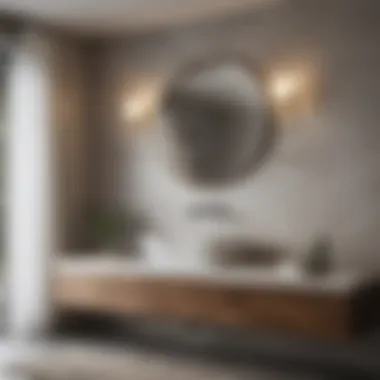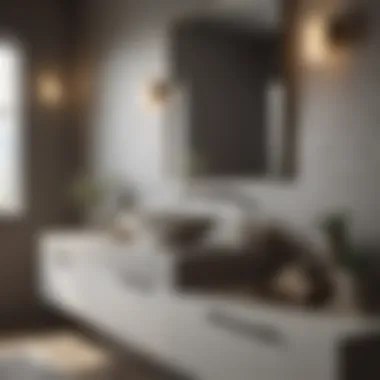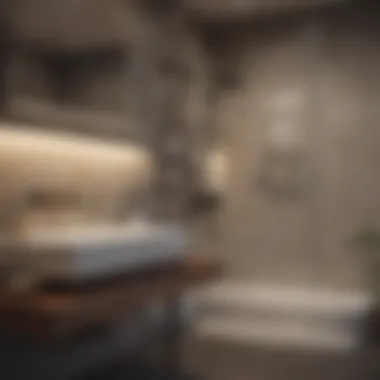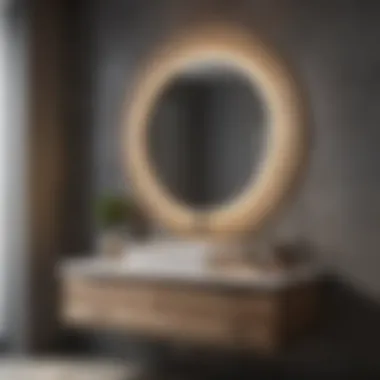Understanding Bathroom Vanity Replacement Costs


Intro
Replacing a bathroom vanity goes beyond mere aesthetics; it can reshape the entire space for enhanced functionality and a refreshed look. But before diving into this renovation project, homeowners must grasp the associated costs to make sound decisions. The financial implications of such a change can vary widely based on several factors including materials, labor, and installation methods.
In this comprehensive guide, we will unpack the various elements influencing the price tags of new vanities. Whether you are considering a DIY project or hiring a professional, understanding the nuances of costs will provide a roadmap for your renovation.
Design Inspirations
When embarking on a vanity replacement journey, design inspiration can ignite creativity and inform choices that reflect your personal style. It sets the tone for not just the bathroom, but the entire home. Let's delve into trending styles and color palettes.
Trending Styles
Bathroom vanities have evolved tremendously, reflecting contemporary tastes.
- Minimalist Designs: Think sleek lines and open spaces that emphasize simplicity while serving functionality. Clean, open designs appeal to modern sensibilities.
- Rustic Finishes: The charm of reclaimed wood and ancient finishes creates a warm, inviting atmosphere. From farmhouse chic to modern bohemian, rustic styles marry function with flair.
- Industrial Touch: With metal accents and raw wood, these designs introduce an edgy, urban vibe that’s perfect for the progressive homeowner.
In a nutshell, selecting a style that resonates with you can significantly enhance the character and comfort of your bathroom.
Color Palettes
When choosing colors for your new vanity, it's essential to create a palette that complements the overall vibe of your bathroom.
- Soft Neutrals: Shades like beige, taupe, and light gray promote calming spaces, ideal for relaxation.
- Bold Hues: Deep blues or dark greens create a striking contrast. They can serve as eye-catching focal points.
- Pastel Touches: Soft pink or mint green can add a playful, uplifting element without overwhelming the senses.
Choosing your color makes all the difference! Think of it as dressing up your bathroom.
Product Recommendations
While the focus may often be on the vanity itself, it’s essential to find compatible accessories that can enhance the experience.
Bath Accessories
Don’t underestimate the power of accessories. Consider these products:
- Faucets: Investing in a high-quality faucet can elevate the bang for your buck. Consider brands like Moen or Delta.
- Mirrors: A statement mirror can tie the whole look together, making the space feel larger.
- Lighting Fixtures: Whether pendant lights or sconces, adequate lighting can enhance both style and practicality.
Bedroom Essentials
While a bathroom vanity is essential, consider how it integrates with the overall décor. Matching bedroom décor adds a cohesive touch. Choose colors and styles that harmonize with not just the bathroom but the adjacent bedroom areas too.
"Knowing when to hire a professional can save both time and money — do your homework and ask for recommendations."
In summary, taking time to understand the various elements of selecting and pricing a bathroom vanity will ultimately empower homeowners to make informed, confident decisions in their renovation projects. Evaluate the design inspirations and product recommendations, and remember that the key to a successful bathroom remodel lies in thoughtful planning.
Understanding Bathroom Vanities
When it comes to home renovations, the bathroom often takes center stage because it serves both functionality and aesthetics. Understanding bathroom vanities is essential for anyone looking to revamp their space. A vanity is more than just a fixture; it can transform the vibe of the bathroom and enhance storage.
The right vanity can tie the whole room together, acting as a focal point. Moreover, it’s crucial to consider how the selection of a vanity aligns with the overall theme of your home. A well-chosen vanity often combines practical storage solutions with a chic design—striking a balance between beauty and utility.
Defining Bathroom Vanity
A bathroom vanity typically encompasses the sink, cabinetry, and countertop all in one cohesive unit. It might appear that vanities are merely decorative pieces, but their practical function can’t be overlooked. They include both visual appeal and utility by providing essential storage for toiletries and towels. When evaluating a vanity, it’s vital to think about your personal needs and bathroom layout.
Components of a Bathroom Vanity
Each component of a bathroom vanity plays a significant role in the overall functionality and appearance of the bathroom. Let’s break down these crucial elements:


Countertops
Countertops are the surface that typically sees the most action. This means they need to be durable and aesthetically pleasing. The most popular materials include granite and quartz.
- Key Characteristic: Durability. Granite, for instance, is heat and scratch resistant, making it ideal for high-use areas.
- Unique Feature: Variety in design. You can find countertops in almost every color and pattern.
- Advantages/Disadvantages: Granite is beautiful but often expensive and might require sealing. Laminate offers an economical alternative but may not last as long and can be prone to scratches.
Sinks
Sinks are where the day-to-day activities happen, so they must be carefully chosen.
- Key Characteristic: Functionality. Double sinks allow for easier use during busy mornings, especially for families.
- Unique Feature: Material options. You’ve got ceramic, porcelain, and even glass sinks to consider.
- Advantages/Disadvantages: A ceramic sink is easy to clean and maintain, while glass adds a modern touch but can be fragile.
Cabinetry
Cabinetry provides storage and can greatly influence the style of the bathroom vanity. It offers a catchy visual and functional element to the design.
- Key Characteristic: Storage space. Adequate cabinetry can declutter your bathroom and keep it more functional.
- Unique Feature: Customization. Custom cabinetry is available to fit niche bathroom dimensions.
- Advantages/Disadvantages: Custom cabinets fit perfectly but can be costly. Pre-made cabinets are budget-friendly but might not meet specific spatial needs.
Hardware
The hardware, including handles, knobs, and faucets, may seem like small details, but they complete the vanity’s overall look.
- Key Characteristic: Aesthetic appeal. Choosing hardware that matches other bathroom fixtures ties the whole design together.
- Unique Feature: Variety and finishes. From brushed nickel to polished brass, the options are numerous.
- Advantages/Disadvantages: Quality hardware augments durability but may come at an increased price. Cheaper alternatives might wear out quickly.
Understanding these elements not only informs the selection process but helps in evaluating the costs associated with replacing a bathroom vanity.
Factors Influencing the Cost
Understanding the factors that influence the cost of replacing a bathroom vanity is crucial. This knowledge empowers homeowners to budget effectively, make informed decisions, and ultimately achieve their desired aesthetic without unnecessary financial burden. The wide array of choices in materials, sizes, and designs can lead to significant variations in price. Here, four main elements are of particular importance: material selection, size and dimensions, and design complexity. Knowing how each of these factors affects costs not only helps in selecting what's appropriate but also in anticipating and managing expenses throughout the renovation process.
Material Selection
Wood vs. Particle Board
When it comes to materials, the choice between wood and particle board is often a make-or-break factor. Solid wood has a reputation for durability and aesthetic appeal. Its unique grains can complement various styles, making it a standout choice for those looking to infuse warmth into their bathroom. On the other hand, particle board, typically more affordable, serves as a widely popular option for budget-conscious individuals. Being made by compressing wood particles, it's susceptible to moisture damage but can still hold its own in terms of design flexibility.
The standout characteristic of wood is its longevity; it can withstand wear and tear over the years. However, it often comes at a higher price point and requires regular maintenance. In contrast, particle board offers cost savings but could, in the long run, lead to additional expenses if it deteriorates faster or needs replacing sooner than expected.
Laminate vs. Stone Countertops
Countertop materials can also play a pivotal role in your vanity's overall cost. Laminate countertops are cost-effective and come in a plethora of colors and patterns, making them a favorite for many homeowners. They are resistant to stains and scratches, making them practical for daily use. Conversely, stone countertops, such as granite or marble, offer a luxurious touch and unmatched durability, but they can send the budget soaring.
Laminate’s primary benefit lies in its affordability and ease of maintenance. Conversely, stone countertops are not just an investment; they provide a level of elegance that can elevate the entire space. Choosing stone can be seen as a long-term investment, as they often increase the property’s value.
Sink Materials
Sink materials are often an underappreciated yet vital component impacting costs. Stainless steel is robust and popular among many homes, providing an industrial feel. It resists stains and is easy to maintain. Alternatively, materials like porcelain add a classic touch but may require more care to prevent chipping.
Stainless steel sinks are generally less expensive and offer practicality, while porcelain sinks might be pricier but bring undeniable charm and elegance. Homeowners must carefully weigh the significance of aesthetics against budget constraints when choosing sink materials.
Size and Dimensions
The size of the vanity will significantly influence both the material required and labor needed for installation. A standard vanity usually starts around 24 inches and goes up to 72 inches or more. Larger sizes may need additional supports or more intricate plumbing adjustments, which can drive the cost higher.
Moreover, those with specific bathroom layouts might need custom-sizing, a process that can get pricey but often pays off in functionality and fit. In general, it’s essential to consider the space you have and what dimensions will work best without compromising the overall layout of your bathroom.
Design Complexity


Custom Designs
Opting for a custom-designed vanity can undoubtedly increase costs but can provide an unbeatable blend of functionality and style tailored specifically to one's needs. These designs can reflect personal taste and harmonize perfectly with the surrounding decor. Yet, such exclusivity often comes at steep prices due to the craftsmanship involved and the unique materials that might be required.
Standard vs. Specialty Styles
On the other hand, standard styles are readily available and generally far more budget-friendly. They can be just as attractive, but they lack the level of personalization that custom designs offer. Specialty styles, however, can elevate the room’s ambiance and can often serve as a stunning focal point, albeit at a higher price.
Regardless of the choice made between custom or standard vanities, each offers its own set of pros and cons. Homeowners must assess their priorities: whether it’s uniqueness and design or practicality and cost-effectiveness.
Average Costs of Replacing Bathroom Vanity
Understanding the average costs associated with replacing a bathroom vanity is crucial for homeowners looking to update their space. This consideration not only impacts the immediate financial outlay but also plays a role in determining budget allocations for the entire renovation project. By assessing various components such as the vanity itself, installation labor, and any additional fixtures, homeowners can craft a clearer picture of what to expect. This enhances informed decision-making, ultimately leading to better satisfaction with the renovations and ensuring they get the best value for money spent.
Cost Breakdown
Vanity Costs
When we talk about vanity costs, we’re really diving into one of the most significant pieces of the puzzle. A vanity can set the stage for the entire bathroom, both in functionality and aesthetic appeal. These costs can vary widely based on materials used, size, and brand reputation. For instance, a solid wood vanity often comes with a heftier price tag compared to something made from particle board, but it typically offers greater durability and longer lifespan.
Key characteristics of vanity costs include the finish quality and style. Custom designs can push costs higher, yet they often provide a tailored look that makes a unique statement in your home. The unique feature of vanity costs is that they can significantly enhance the space's overall appearance but can also eat into a budget quickly if not managed wisely. Therefore, keeping an eye on both your desires and your budget is vital to ensure that the vanity is a solid investment.
Installation Labor
Installation labor is another piece of the costs pie that can’t be overlooked. Depending on the complexity of the installation, these costs can fluctuate. Engaging a professional can save time and avoid potential missteps, particularly for those not well-versed in home renovations. The key characteristic of installation labor is its reliance on expertise; skilled labor can not only ensure a smoother installation but often results in fewer issues down the line.
One distinctive aspect of providing professional installation versus DIY is the guarantee of proper fittings. Many homeowners underestimate the nuances of plumbing and alignment—issues might crop up if attempts are made without adequate knowledge. Although hiring a professional may up the overall expense, it could save future costs related to misinstallations.
Additional Fixtures
Additional fixtures contribute substantially to the final expenses when replacing a bathroom vanity. This encompasses faucets, mirrors, lighting, and even the plumbing components that may need upgrading along with the new vanity. One notable characteristic of these costs is their potential for flexibility; for example, opting for a mid-range faucet rather than a luxury brand might yield significant savings while maintaining functionality.
The unique feature of considering additional fixtures is that they can dramatically influence both the aesthetics and practicality of the space. While it’s tempting to go for the latest trendy items, discerning homeowners recognize that looking for timeless pieces can often lead to better long-term value. Also, it’s crucial to consistently align these decisions with the existing style of the bathroom to avoid any design mismatches.
Regional Price Variations
Some cities may have a competitive market for contractors, leading to lower labor costs, whereas others might suffer from a shortage of skilled tradespeople, driving prices upwards. This aspect reinforces the significance of thorough research; knowing your regional pricing dynamics can be the difference between overspending and making a smart investment. To illustrate this, an average vanity replacement could range anywhere from $500 to $2500 or more, depending heavily on location, choice of materials, and labor costs in that area.
DIY vs. Hiring Professionals
When it’s time to replace a bathroom vanity, one of the first decisions homeowners face is whether to tackle the job themselves or bring in a professional. This choice is laden with considerations that can affect not only the costs but the overall outcome of the project. Understanding the factors weighing in on DIY versus hiring professionals is essential for making an informed decision that suits both your budget and your needs.
Considering Skills and Tools
Before diving into a DIY project, assessing your skills and the tools you possess is crucial.
- Skill Level: If you’re somewhat handy and have experience with basic plumbing and carpentry, you might be able to pull off a vanity replacement without much fuss. However, if these terms sound foreign to you, it might be wise to step back.
- Tools Required: A successful vanity replacement involves more than just muscle. You’ll need tools like a level, pipe wrench, drill, and possibly a sander if you’re refinishing surfaces. If you don’t have these tools on hand, you either have to buy them, which can spike your costs, or rent them, which can still be a hassle.
If you opt to go the DIY route, consider the learning curve. Gaining knowledge can be enriching, but also be realistic about the time required to learn and implement new skills.
Cost Comparisons
Labor Costs
Labor costs present a significant consideration when comparing DIY with hiring professionals. It’s palpable to think about costs here because they often make up a large chunk of the overall budget.
- Key Characteristic: Professional installers usually charge by the hour or project, depending on their expertise and the job's specifics. In many cases, average installation rates linger between $50 to $150 per hour.
- Reason for Hiring: Professional work often comes with a guarantee of quality, and they tend to work faster due to their experience. An expert’s insight can prevent mistakes that a novice might make, thus saving money in the long run.
- Unique Feature: Hiring a professional can be a beneficial avenue for complex bathrooms or intricate vanities. The skill and knowledge they bring to the table can ensure proper alignment, secure plumbing connections, and adherence to local building codes.


Nevertheless, the downside is the potential for an unforeseen high bill, especially if the project extends beyond the initial estimate.
Time Investment
Time investment is another vital component when it comes to choosing between DIY and hiring professionals.
- Key Characteristic: Replacing a vanity incorrectly can lead to time-consuming repairs. A professional can not only perform the work more efficiently, but they often have the ability to solve unexpected issues on the spot.
- Benefits for DIY: On the flip side, embarking on the DIY route might save you money, but it could eat into your personal time—weekends can slip away quickly in projects that run over due to inexperience.
- Unique Feature: Balancing the time you could spend with family and leisure activities against the hours you’ll spend on installation is something to ponder closely. Choose wisely; time is often the unacknowledged cost in home improvement projects.
"Sometimes, the biggest savings don't show up on the receipt but in the time you save from not doing it yourself."
Navigating whether to handle the installation yourself or hire a pro doesn't have a one-size-fits-all answer. Assess your skills, time availability, and the complexity of the project to discover the path that best fits your circumstances.
Maximizing Value Through Smart Choices
When it comes to renovating or updating your bathroom, making smart choices can heavily influence both the financial cost and the overall satisfaction you feel about the project. Particularly with replacing a bathroom vanity, focusing on maximizing value can lead to a more rewarding outcome that doesn't break the bank. Essentially, it’s not just about choosing the least expensive options; it’s about finding the best bang for your buck that enhances both functionality and aesthetics of the space.
Before diving into specific choices, it’s vital to consider what value means in your particular context. For some, it could be about longevity; for others, it might hinge on trendy designs. Smart choices revolve around a mix of understanding your needs, budget, and the overall vision you have for your bathroom.
Imagine choosing a beautiful vanity, only to find you have to shell out major dough just to maintain it—no one wants that sticky situation! On the flip side, a smart choice today could mean significant savings down the line.
Affordable Material Options
Selecting the right materials is often the cornerstone of maximizing value. Luckily, there are many affordable material options that don't sacrifice design for cost. Here are key materials to consider:
- Laminate: A cost-effective option, laminate is easy to clean and comes in a plethora of colors and finishes. It can often mimic the look of more expensive materials like wood or stone without the hefty price tag.
- MDF (Medium Density Fiberboard): This engineered wood product offers durability at a lower price. It's a solid choice for cabinetry, especially when covered with a nice veneer.
- Composite Stone: If you're dreaming of a stone countertop but don’t have the budget for granite or marble, consider composite stone. It provides a similar look and performance while being easier on the wallet.
"Choosing affordable materials can significantly influence your renovation budget without skimping on style."
It’s important to remember, though, that going too cheap can lead to higher maintenance costs over time. Finding a balance is the key.
Design Trends That Add Value
Staying in touch with current design trends can also help enhance the value of your vanity replacement. Some trends stand out not only for their aesthetics but also for their potential return on investment. Here are a few:
- Floating Vanities: These create the illusion of space, making smaller bathrooms feel larger. It’s a modern look that appeals to homebuyers.
- Dual Sinks: In family settings, having two sinks is a significant draw. This added functionality can add value when you go to sell your home.
- Smart Storage Solutions: Custom cabinetry that maximizes storage space can elevate the overall experience in your bathroom while minimizing clutter.
Incorporating design elements that are practical yet stylish can significantly increase the appeal of your bathroom, giving you a return not just in function, but also when it comes time to sell.
By weighing your options carefully and keeping an eye on both costs and design trends, you can boost the value of your bathroom vanity without breaking a sweat—or the bank!
Lifecycle Considerations
When contemplating the replacement of a bathroom vanity, it's not just a matter of picking a pretty piece of furniture and calling it a day. Lifecycle considerations play a crucial role in the overall value of your investment, influencing both the immediate costs and the long-term sustainability of your choice. Examining how long a vanity will last, its maintenance requirements, and when to eventually replace it will provide a clearer picture of the financial landscape that lies ahead.
Understanding Maintenance Costs
Every bathroom vanity requires a level of ongoing care that homeowners must understand before committing to a purchasing decision. Different materials come with varying maintenance needs:
- Wood vanities, for instance, may need regular polishing and a vigilant eye for moisture damage.
- Alternatives like laminate require minimal upkeep but might not hold up as well to wear and tear, leading to earlier replacement.
Understanding these costs up front can be helpful. A vanity might initially appear budget-friendly, but if it demands repeated repairs or refinishing, those supposedly lower costs can quickly add up. DIY fixes might seem like an easy answer, yet they consume time and effort that could be spent on more rewarding projects.
Additionally, think about the long-term implications of your choice. For instance, some stone countertops require sealing to maintain their beauty and prevent stains, adding to the ongoing expense.
"Investing in a bathroom vanity is more than a style choice; it's about understanding what comes next."
When to Replace Your Vanity
Knowing when it's time to swap out an old vanity can save headaches down the line. Signs that replacement is necessary can manifest in different ways. For example:
- Structural Issues: If the wood is rotting or the base is developping cracks, it’s time to part ways.
- Style Evolution: Trends do shift, and what was once in vogue could quickly become an eyesore.
- Functional Needs: Families grow, and with them, the need for more storage or a double sink setup might arise.
It’s wise to keep a yearly checklist. Every so often, evaluate the condition of your vanity. Look for signs of wear, check the functionality of hinges and handles, and consider how well it meets your current needs. This proactive approach allows you to optimize your spending, ensuring that your investment reflects not just current style but long-term utility as well.



